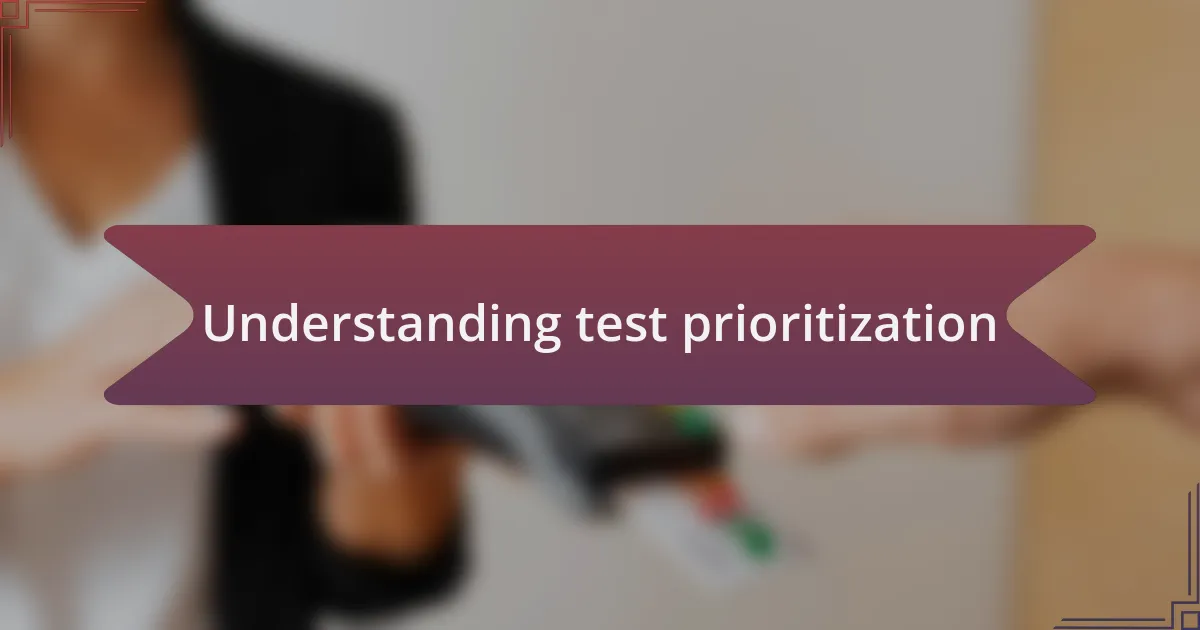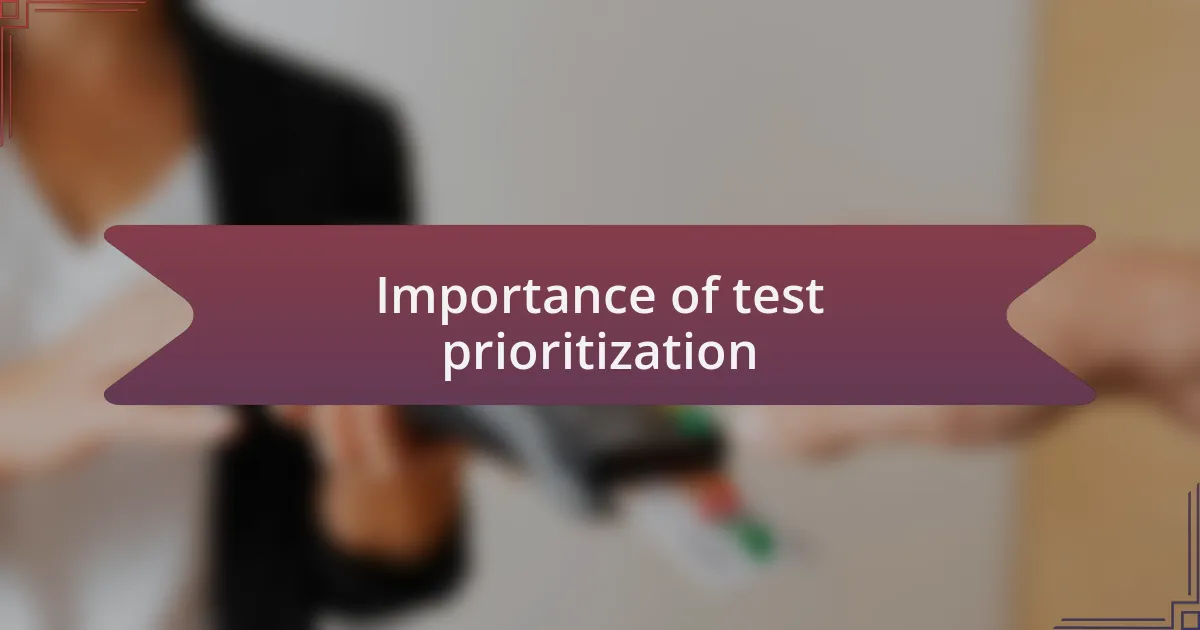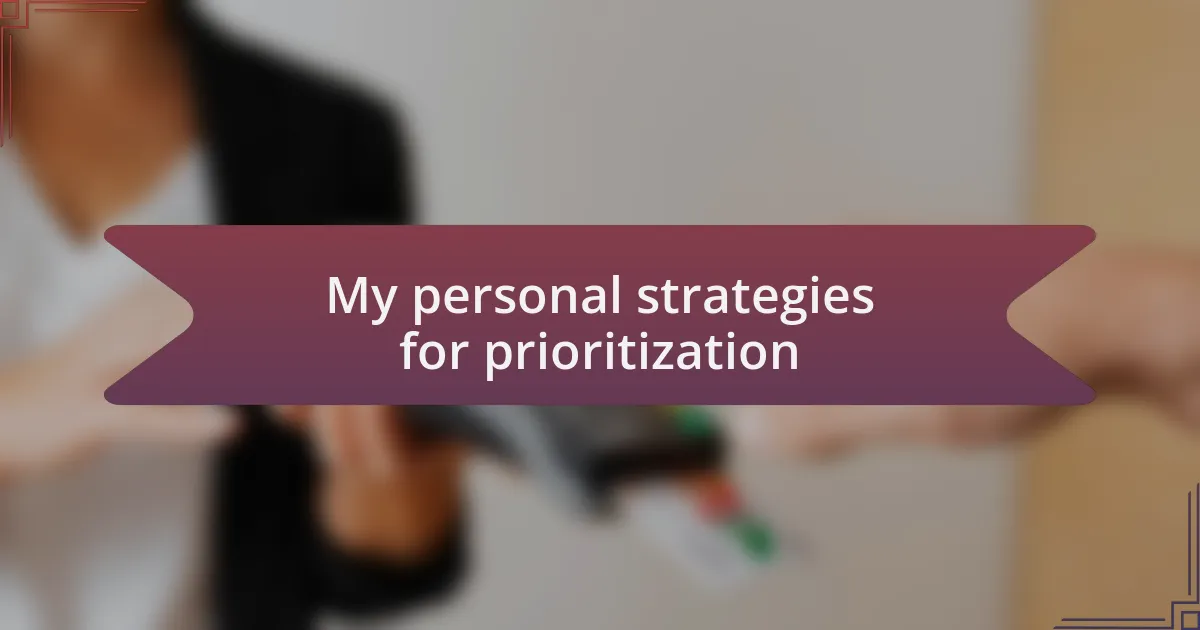Key takeaways:
- Test prioritization is essential for focusing on the most critical aspects of a software project, similar to triaging in a hospital.
- Effective prioritization leads to improved resource allocation and alignment with user needs, enhancing both product quality and team morale.
- Key factors influencing prioritization include risk assessment, the development lifecycle stage, and stakeholder feedback.
- Adopting techniques such as value-based prioritization, test automation, and defect-based prioritization can significantly enhance testing efficiency and outcomes.

Understanding test prioritization
Test prioritization is about identifying which tests are most critical for your software project. It’s a bit like triaging in a hospital—deciding where your time and resources will have the most significant impact. I’ve often faced situations where I had to make tough calls, and I always remind myself: what will provide the most value to my end users?
When I began in software testing, I remember feeling overwhelmed by the sheer number of tests we could run. I found myself asking, “Which tests will truly safeguard against failures that will affect users the most?” This question drove me to develop an approach based on risk assessment and impact, helping to ensure that the most critical features received my attention first, ultimately leading to a more robust product.
As I navigated my early projects, I discovered that collaboration is integral to effective test prioritization. Engaging with developers and stakeholders revealed priorities I might not have considered. Have you ever overlooked a key feature because it seemed less critical at first glance? Reflecting on these dynamics has consistently reminded me that understanding the team’s collective vision and user needs elevates our prioritization strategy significantly.

Importance of test prioritization
When I think about the importance of test prioritization, I often recall a project where a minor feature unexpectedly led to a major user complaint. We had spent hours perfecting what seemed like the crucial components of our application, but our oversight in prioritizing tests for that seemingly small feature resulted in a backlash that caught us off guard. This experience taught me that even the less obvious elements of a project deserve careful consideration; prioritizing tests effectively can mean the difference between user satisfaction and frustration.
I remember one particular sprint where our team faced a decision: should we focus on extensive regression testing or prioritize new feature tests? The pressure was palpable. I leaned into my experience and advocated for prioritizing the new features since they were aligned with our upcoming release, which directly impacted our users. This decision not only saved us time but provided our users with immediate value, reinforcing the idea that prioritization must align with project goals and user needs.
Moreover, prioritizing tests leads to improved resource allocation. I’ve seen teams burn through budgets and deadlines by running exhaustive tests on everything, leaving little room for critical assessments. Isn’t it better to leverage our resources to yield the most significant results? Focusing on high-impact tests ensures that we deliver quality without sacrificing efficiency, ultimately enhancing both the product and team morale. Prioritization transforms our approach from merely checking boxes to strategically advancing our goals.

Key factors influencing test prioritization
When I consider test prioritization, one key factor that stands out is risk assessment. For instance, in a recent project, we had a feature that interfaced with sensitive user data. Due to the potential repercussions of a security breach, we made the conscious decision to prioritize tests around this feature. It made me realize that when risks are high, our testing efforts must be laser-focused on those areas that could cause significant harm if left unchecked.
Another influencing factor is the stage of the development lifecycle. There was a time when I witnessed the frantic pace of development in a sprint, where our test focus shifted almost weekly. In those instances, tests for new functionalities naturally took precedence over older ones. This experience emphasized how the dynamic nature of a project requires a flexible approach to prioritization. How often do we overlook tests for older features just because they “seem” stable?
Lastly, stakeholder feedback plays a crucial role in shaping priorities. I vividly remember a scenario where user feedback on a recently launched feature prompted us to reassess our testing strategy. The initial tests, which I thought were adequate, suddenly seemed insufficient in light of user concerns. So, how often do we engage with users and incorporate their insights into our testing priorities? From my experience, listening to user feedback can provide invaluable context that refines our testing focus and ultimately strengthens the product.

Techniques for effective test prioritization
One effective technique I often use for test prioritization is the implementation of value-based prioritization. When I think back to a project where we introduced a new payment feature, it was crucial to align our testing with the value delivered to the user. By evaluating which tests would directly impact user satisfaction and retention, I realized that focusing on those scenarios gave us the most bang for our buck. Have you ever assessed features solely based on the value they bring to users?
Another method I’ve embraced is the use of test automation, especially for regression testing. I recall a particularly intense release period when we were crunched for time. Automation not only expedited our testing process but also allowed us to prioritize manual tests for new features that needed careful scrutiny. It was a game changer, freeing up time to focus on high-risk areas and ultimately enhancing our overall testing efficiency. How much time do you think automation could save you in your testing endeavors?
Lastly, employing a defect-based prioritization approach has proven effective for me. After identifying several recurring defects in one project, it became clear that testing should focus on those areas that historically presented challenges. By paying attention to where bugs often emerge, I crafted a targeted strategy that not only improved our test coverage but also reduced the frustration of repeated issues. Reflecting on this, how often do we review past defects to inform our current test priorities? This technique has highlighted the importance of learning from our experiences for smarter testing strategies.

My personal strategies for prioritization
When it comes to my personal strategies for prioritization, I often rely on risk assessment as a guiding principle. I remember a time when we faced a major deadline and had to decide which parts of our software to test first. By analyzing potential risks and the impact of failure, I could prioritize tests that guarded our most critical functionalities. Isn’t it fascinating how identifying what’s at stake can steer our focus in testing?
Another strategy I’ve developed is involving my team in the prioritization process. Early in my career, I discovered the incredible value of collective insights during a particularly chaotic project. Asking team members for their perspectives not only brought fresh ideas to the table but also fostered a sense of ownership among everyone involved. How often do we miss out on innovative approaches simply because we don’t tap into our team’s collective knowledge?
Finally, I believe in the power of iterative prioritization. In one project, as we received ongoing feedback from users, I realized that our testing focus needed to adapt in real-time. This approach made our testing dynamic and more aligned with user needs, rather than static and predetermined. Have you ever reconsidered your priorities mid-project and found it enhanced your testing efficiency? Embracing flexibility in prioritization can truly lead to better outcomes.

Case studies on my strategies
One case that stands out in my memory involved a large-scale application launch. We had multiple features to test, but I quickly realized that our focus shifted when a major client expressed concerns about a specific functionality. By responding to that feedback and reallocating our testing resources, we not only reassured the client but also built stronger relationships, showcasing the pivotal role of adaptability in prioritization. Have you ever noticed how the needs of stakeholders can reshape your testing focus?
Another instance highlights the value of data-driven prioritization. During a project, we conducted an analysis of bug reports and user feedback, uncovering that certain areas were prone to errors much more frequently than others. Focusing our efforts on these high-risk zones proved invaluable; our test coverage drastically improved, and we saw a significant dip in post-release issues. It’s intriguing to think about how harnessing data can refine our prioritization strategies, isn’t it?
Lastly, during a particularly fast-paced project, we adopted a sprint-based approach. This methodology enabled us to prioritize tests at the end of each sprint, aligning closely with our development cycles. As we celebrated small wins after each sprint, the team felt a renewed sense of purpose and motivation. I often wonder if this kind of incremental recognition could be the key to maintaining team morale and performance in other contexts.

Evaluating success of my strategies
When evaluating the success of my test prioritization strategies, I often reflect on metrics like defect density and customer satisfaction. One memorable project had us tracking post-release bugs closely; a noticeable drop was a clear indicator that our prioritization was working. Isn’t it rewarding when numbers reflect our hard work?
Additionally, I pay close attention to team feedback during retrospectives. I remember a time when a junior developer suggested tweaks to our prioritization process that made a substantial difference. Engaging the team not only fostered a collaborative spirit but also provided fresh perspectives that enhanced our overall strategy. Have you considered how team input can elevate your testing approach?
Moreover, I find that keeping a close eye on client feedback helps measure the effectiveness of our efforts. After a major release, the positive comments from users felt like applause for our prioritization decisions. It’s fascinating how a simple piece of feedback can validate months of effort and realign our focus for upcoming projects, isn’t it?